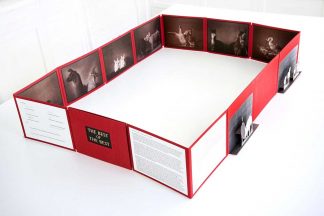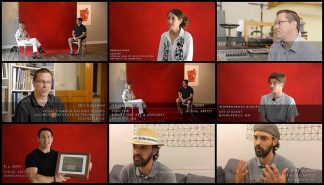By Allison Campbell-Jensen
“The idea of the artists’ book is that you are combining the aesthetic of an object with a concept,” says Deborah Ultan, Curator of the Francis V. Gorman Rare Art Books & Media Collection. “You’re creating something that is both visually exciting as much as or maybe more so even than the text.”
Artists’ books play with the ideas of form and function, as architecture and design do.
Now, the virtual artists’ book is emerging from the evolution of books.
The evolution of books — and artists’ books
The roots of artists’ books are as deep as cuneiform writing. “The engraved lettering, which were shapes in the clay. That’s really almost the beginning of books,” Ultan says, “and also you can think of it as an artistic form.”
The illuminated manuscripts created by monks are another step in the evolution of books.
“With the virtual artist book, the idea is to maintain that we are not just reading to gain knowledge, we’re doing it for the experience.”
—Deborah Ultan
“Then we have Gutenberg, where we understand how the printing press makes these entities more obtainable, accessible,” Ultan says. The idea of sharing arose. Yet “quality became less important than accessibility. But accessibility and quality are in a constant dance. The most obvious example of that is the paperback versus the cloth book.”
In the 1960s and ’70s, the copy machine made the idea of copying and sharing very exciting for artists who wanted to get their work out in the world cheaply, bypassing publishers and the mainstream press.
“We have an artists’ book that was created — it was a performance that became a book,” Ultan says. A museum in Madrid set up a fax machine and artists faxed in their artwork. “The fax machine was pumping out all this stuff that was all over the museum. Then it was eventually assembled, and the book became an artifact of that performance. Not high quality, but an exciting experience — something that was very collaborative.”
Ultan notes that the Gorman Collection has examples of many different artists’ books over time, from cuneiform to the latest artists’ books by local artists. “We don’t have an illuminated manuscript; we do have a facsimile of the Book of Kells,” she says.
A virtual artists’ book

R. J. Kern
Now, as a step in the evolution of the book, we have the e-book. “That has opened up a different window of how we read and study,” she says. And the electronic format has been adopted by book artists.
“With the virtual artist book,” Ultan says, “the idea is to maintain that we are not just reading to gain knowledge, we’re doing it for the experience.”
The path to collecting one for the Gorman Collection began when Ultan met artist R. J. Kern a couple of years ago for a discussion about artists’ books focused on photography, especially from the 21st Editions collection. He told her about his upcoming project, “The Best of the Best,” which she purchased after it was completed.
Earlier this year, he contacted Ultan to ask what he could do, as libraries weren’t collecting in the time of COVID. She suggested he look into a virtual artist book, a form that was already being explored yet took on more significance because of the pandemic. Kern was intrigued. He decided to experiment with “The Best of the Best.”

The Best of the Best by R.J. Kern
“You could just create a facsimile of an artists’ book. But that’s not what this is,” Ultan says. “This actually explores how the virtual format can still provide a book experience that is engaging and transforming.” In a video introduction to Kern’s virtual artists’ book, she says this step in the evolution of the book relies on creative and theatrical uses of technology.
The Gorman Collection is purchasing Kern’s virtual artist book. “R.J. made sure to create a very playful, interactive element to it,” Ultan says. “So it’s that idea of having your own experience with the book.” She expects users to be able to view it online in a couple of weeks.
The nature of books
Even as the paradigm has shifted with books, they still retain a certain character. “There’s this sacred idea of our books,” Ultan says. “We like to collect them, we like to share them, we like to show them off, or we like to keep them secret. They are very personal and they can take on so many different layers of meaning.” Even in a virtual environment.





